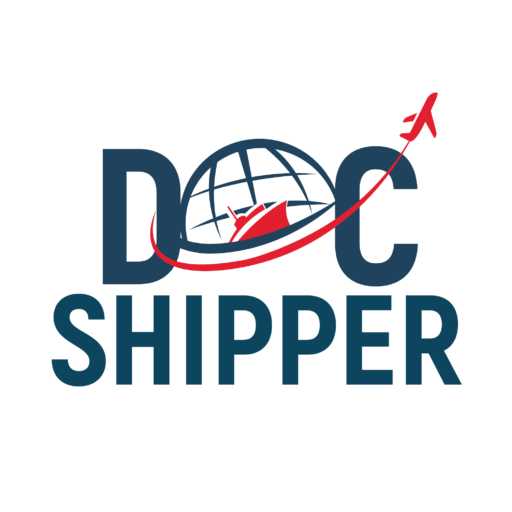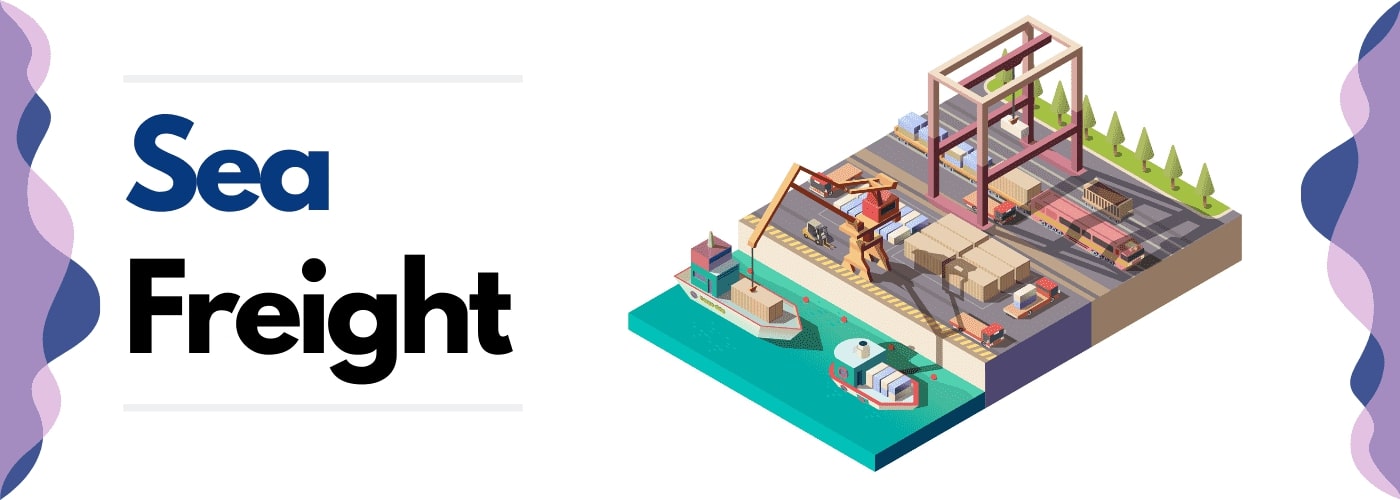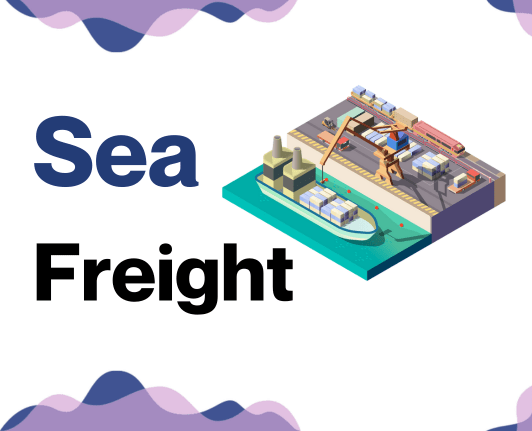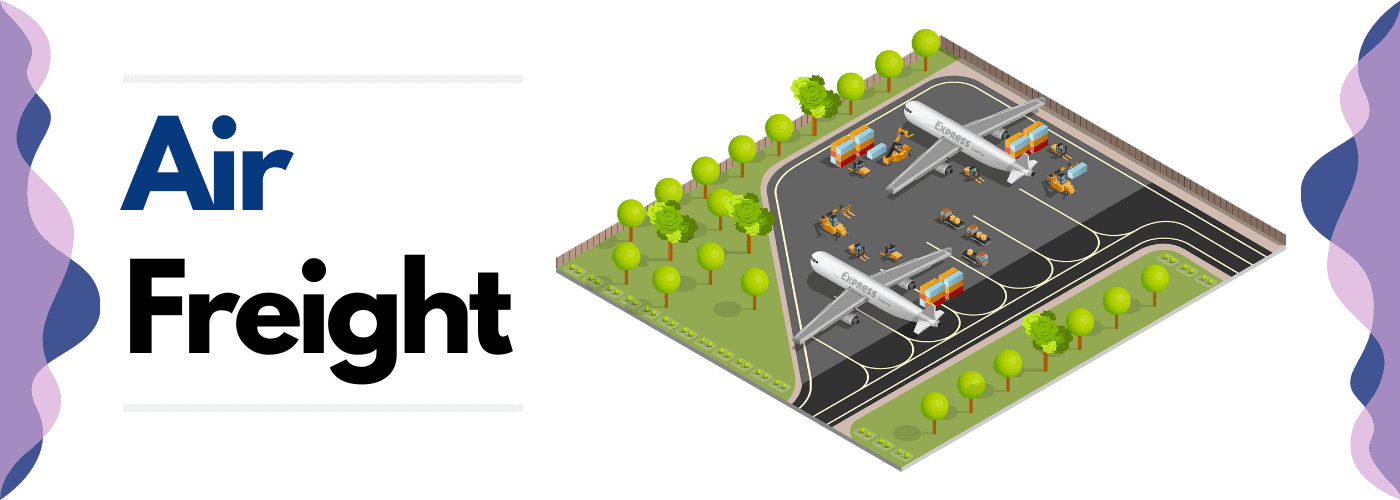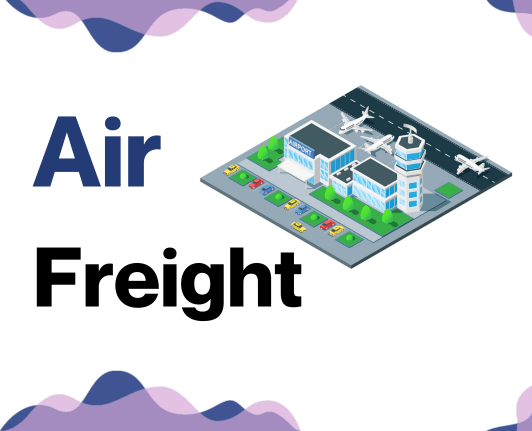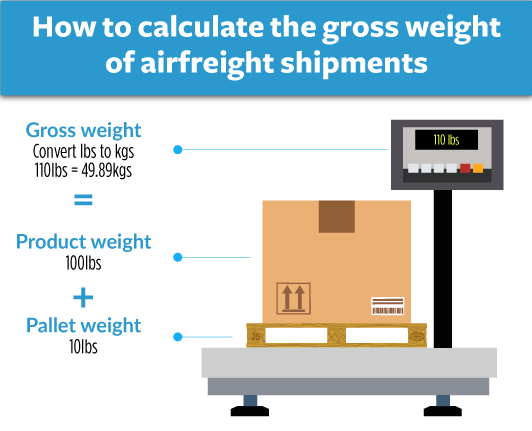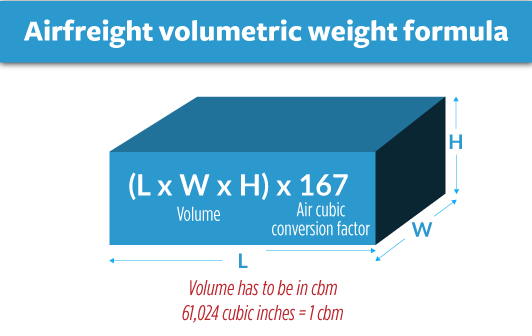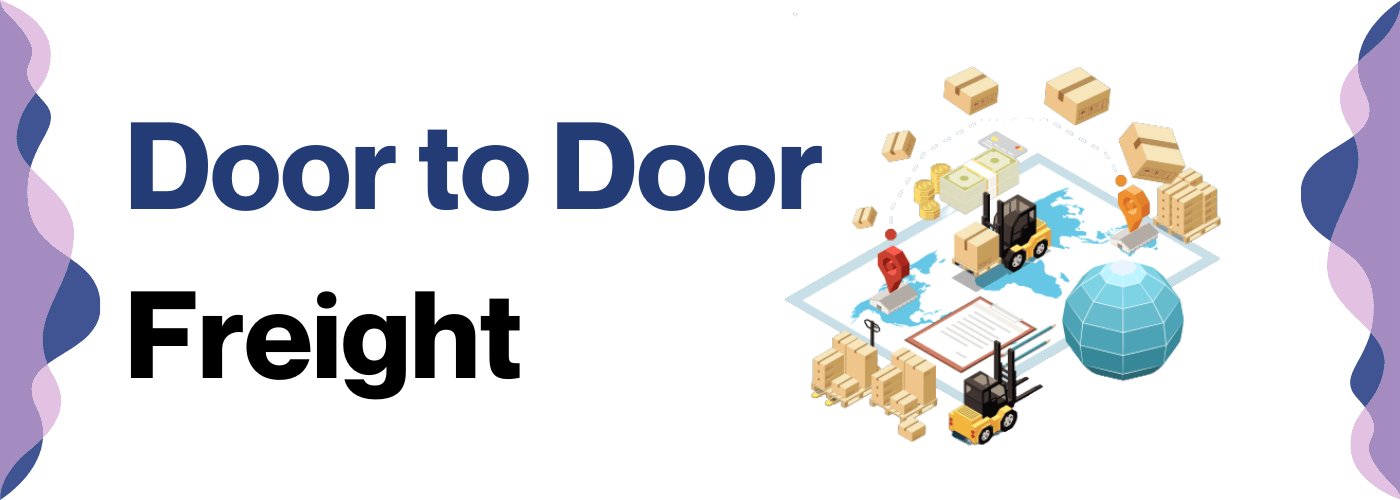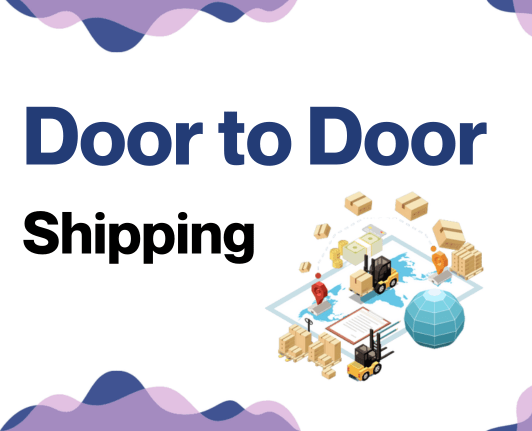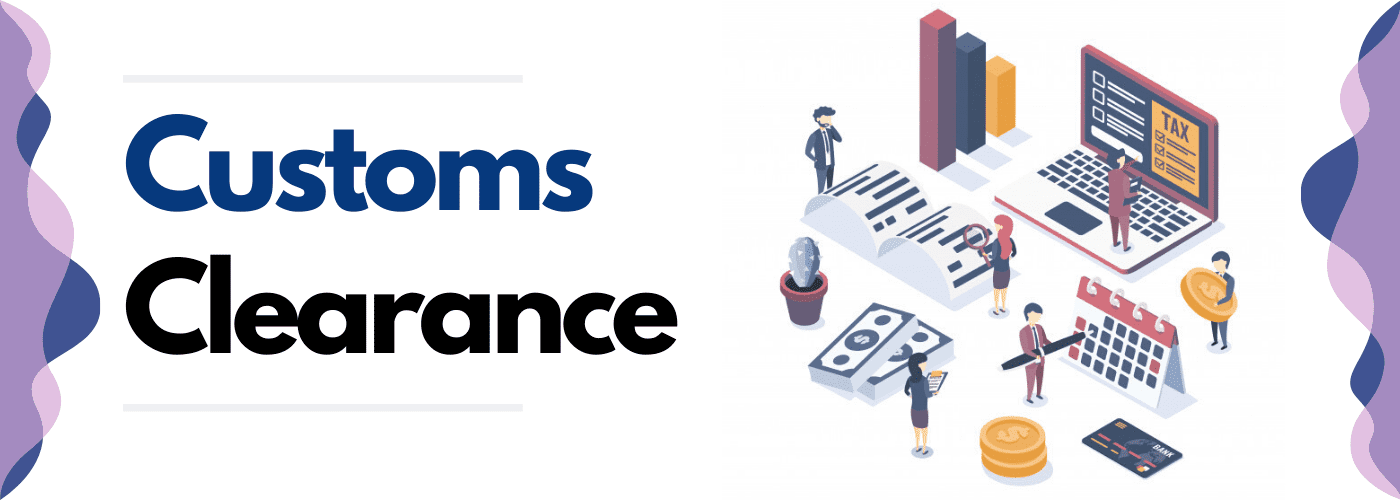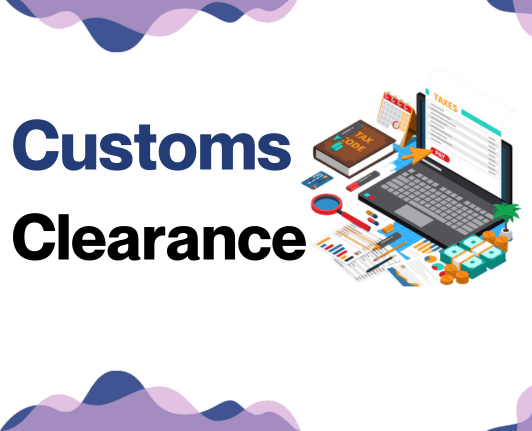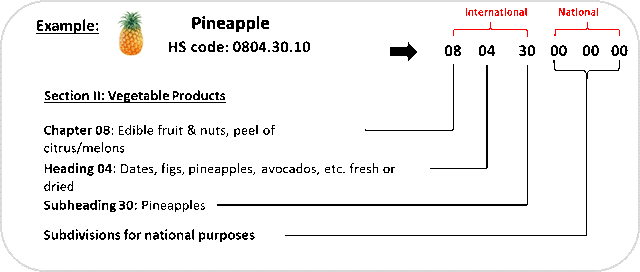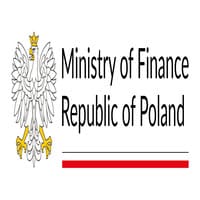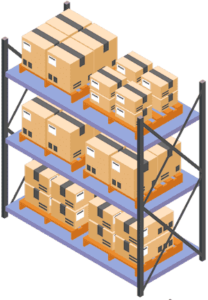Picture this, you're planning to ship a camel from Qatar to Poland - well, it's not quite that complicated, but shipping freight can sometimes feel that way. Deciphering rates, grappling with transit times, and navigating customs regulations can truly test your patience. This guide is your beacon in these choppy waters, armed with extensive information about air, sea, road, and rail freight options, along with a detailed look at customs clearance, duties, and taxes. We will not only familiarize you with the intricacies of such transactions but also tailor our advice to your business's specific needs. If the process still feels overwhelming, let DocShipper handle it for you! We are an international freight forwarder dedicated to turning your freight transport challenges from Qatar to Poland into success stories for your business.
Which are the different modes of transportation between Qatar and Poland?
Choosing the best method to transport goods from Qatar to Poland can be likened to solving a puzzle: each country's geographical specifics serve as the pieces. Surrounded by borders and saltwater, land transport gets complex. Journey thousands of miles may steer you away from air freight's higher costs. Our focus shifts rightfully to sea transport, the cargo ship coursing water pathways like a champion swimmer. As the most practical solution, seabound freights balance expenses and transit time. Carefully selecting your transportation aligns with effective shipping, catering to your deliveries just as a well-stitched suit fits its wearer.
How can DocShipper help?
Looking to ship goods between Qatar and Poland? Lean on DocShipper's expertise to streamline the process. We handle everything - from customs clearance to delivery, ensuring a hassle-free experience for you. Interested? Get in touch for a free estimate within 24 hours. Our consultants are just a free call away to answer your queries.
DocShipper Tip: Sea freight might be the best solution for you if:
- You're dealing with hefty quantities or large-scale goods. Sea freight is your go-to for maximizing space without stretching your budget.
- Your cargo doesn't have an urgent deadline, as sea freight typically has longer transit times compared to air or rail.
- Your shipping routes are between major ports, allowing you to leverage the extensive global network of sea shipping lanes.
Sea freight between Qatar and Poland
Shipping goods between Qatar and Poland via ocean freight is like connecting two puzzle pieces - strategic, yet not without challenges. Extending over the Arabian Sea and the Baltic Sea, the maritime route links Qatar's Ras Laffan port with Poland's Gdynia port, fostering strong trade ties. It's like a well-oiled machine that transports high-volume goods, groaning with weight, yet economically effective. Still, the joy of affordable freight fades with the snail-paced journey, but for many, the savings outweigh the speed.
Picture this: you want to ship your goods, but confusion and errors crowd your journey. The problem? A maze of regulations and complexities typical in the path between these two nations with unique customs requirements. But, don't fret! There's a map to this, a blueprint of best practices to a smoother journey, and we will unroll that in this section. With patience and guidance, your shipping hassles can be a thing of the past. Remember, the sea may be rough, but the best sailors are made in stormy weather!
Main shipping ports in Qatar
Hamad Port
Location and Volume: Located on the southeastern coast of Qatar, near Mesaieed, this port is a critical gateway for Qatar's trade, handling more than 60% of the country's total maritime trade with a shipping volume of over 2 million Twenty-Foot Equivalent Units (TEUs).
Key Trading Partners and Strategic Importance: Its central location in the Persian Gulf makes it a crucial connection point for several trading partners such as India, China, Iran, and Oman. Furthermore, Hamad Port handles the export of Qatar's key commodities, including natural gas, oil, and petrochemicals.
Context for Businesses: If you're looking to export large quantities of goods to the Middle Eastern and Asian markets, Hamad Port is an optimal choice given its high cargo capacity and advantageous geographical location.
Ras Laffan Port
Location and Volume: Positioned to the North of Qatar, Ras Laffan is not as voluminous as Hamad but extremely important in the world of energy exports, hosting one of the largest Liquefied Natural Gas (LNG) exporting facilities globally.
Key Trading Partners and Strategic Importance: The port mostly trades with countries heavily reliant on gas imports, including Japan, South Korea, and India. Ras Laffan's strategic importance lies in being the key export hub for Qatar's vast resources of natural gas.
Context for Businesses: If your business lies in the oil & gas sector, operating or collaborating with entities at Ras Laffan Port can be strategically significant due to its dedicated infrastructure for LNG and oil products.
Doha Port
Location and Volume: Situated in the heart of Qatar's capital city, Doha, this port served as the primary sea gateway before the opening of Hamad Port. While Doha Port is now primarily a destination for cruise ships, it still handles a modest volume of cargo.
Key Trading Partners and Strategic Importance: Doha Port has historically had close trading ties with various gulf countries, playing a regional role. Now, it's evolving as a cruise destination, aligning with Qatar's growing focus on tourism.
Context for Businesses: Although Doha Port may not be the first choice for large-scale exporters, tourism-related businesses can greatly benefit from the traffic it brings, effectively utilizing this location to reach a wider audience.
Main shipping ports in Poland
Port of Gdańsk
Location and Volume: Positioned in the Baltic Sea region at the heart of the Gulf of Gdansk, Port of Gdańsk plays a significant role in handling Poland's maritime trade, boasting a shipping volume of nearly 52 million tons in recent years.
Key Trading Partners and Strategic Importance: This port maintains key trading alliances with countries such as the UK, Belgium, and the Netherlands, and serves as a crucial gateway to the rest of Europe, boasting a deepwater container terminal that enables it to handle large container ships.
Context for Businesses: If your business objective includes expanding your reach to the Northern and Central European markets, the Port of Gdańsk could be central to your logistics strategy due to its advanced infrastructure and extensive maritime trade network.
Port of Gdynia
Location and Volume: Situated in the Southern Baltic area, Gdynia Port is a vital hub for maritime economy in Poland. With a shipping volume of over 21 million tons a year, it is a key center for cargo handling and shipping.
Key Trading Partners and Strategic Importance: Gdynia Port's main trading partners consist of countries such as Germany, Russia, Sweden, and Finland. The port is strategically important due to its accessibility and the fact that it's one of the few ice-free ports in the Baltic Sea.
Context for Businesses: If your logistics requirements involve consistent year-round shipping, even during freezing winter months, you could benefit from incorporating the Port of Gdynia into your shipping plan. Its consistent ice-free status allows for uninterrupted logistics operations throughout the year.
Port of Szczecin-Świnoujście
Location and Volume: Located near the German border and covering both the cities of Szczecin and Świnoujście, this port is a critical element of maritime trade for the Polish and international community, boasting a shipping volume of 25 million tons per year.
Key Trading Partners and Strategic Importance: The port partners primarily with countries like Germany, Russia, the Netherlands, and the UK, acting as an important grain export terminal, which contributes to its strategic significance.
Context for Businesses: The Port of Szczecin-Świnoujście could factor greatly into your shipping strategy if your business involves the production or international trading of grains and other bulk agricultural products. Its role as a top grain export terminal can enhance the logistics of such trade significantly.
Should I choose FCL or LCL when shipping between Qatar and Poland?
When shipping goods from Qatar to Poland, your choice between Full Container Load (FCL) and Less than Container Load (LCL) can directly affect cost, timelines, and the success of your logistics process. This section is your key to unraveling these two main sea freight options. Here, you'll decipher which approach aligns best with your specifics - be it the volume of your goods, budget considerations, delivery deadlines, or overall strategy. This knowledge can be nothing short of a game-changer in your quest for efficient, effective shipping. Ready to dive in? Let's illuminate your path to decision-making mastery.
LCL: Less than Container Load
Definition: LCL (Less than Container Load) is a method of shipping where different consignments from multiple shippers are consolidated into a single container. It is often referred to as groupage shipping.
When to Use: It's ideal to choose LCL shipment when your shipment is too small to fill a full container. Typically, if your cargo is less than 13-15 cubic meters (CBM)—roughly about half the size of a single garage—it might be more cost-effective to opt for LCL freight.
Example: If a Qatar-based company 'QTech' needs to send equipment weighing around 10 CBM to their branch in Poland, LCL will be the optimal method as their shipment wouldn't fill up a full container.
Cost Implications: The cost of LCL shipment largely depends on the volume of the cargo, not its weight. 'QTech', in our example, would only pay for their 10 CBM space in the shared container. This would be significantly cheaper than booking a full 20-foot container at a fixed rate. However, additional costs like handling fees on both ends should be considered as these can sometimes make LCL less cost-effective.
FCL: Full Container Load
Definition: FCL (Full Container Load) shipping is a mode of transport where a shipment occupies an entire container, whether it's a 20'ft or 40'ft. This means the container is sealed at its origin and remains unopened until it reaches the destination.
When to Use: Opt for FCL shipping when your cargo is more than 13/14/15 CBM. Since the container is not shared with other shipments, there's a reduction in the risk of damage or delay, making it ideal for large, heavy, or fragile shipments.
Example: Consider a furniture firm in Qatar shipping 20 CBM of tables and chairs to a customer in Poland. Due to the volume and vulnerability of their goods, they'd choose FCL, ensuring safer delivery and justifying the fcl shipping quote.
Cost Implications: FCL is more cost-effective for larger volumes; the per unit cost decreases the more volume you ship. A container is yours to fill, hence, regardless of the cargo's size or weight within a 20'ft or 40'ft FCL container, the fixed rate is charged. However, remember to compare FCL and LCL costs; if less than half the 20_FT container is filled, LCL might be cheaper.
Unlock hassle-free shipping
Choosing between consolidation and full container shipping can be a daunting task. Let DocShipper simplify your logistics needs. Our dedicated team of ocean freight experts weighs several factors like shipment size, time sensitivity, and cost-effectiveness to recommend the best shipping option for your business. With the aim of making cargo transport hassle-free, DocShipper puts your business first. Why not contact us today for a free, no-obligation estimation? We're ready to make your shipping operations smoother.
How long does sea freight take between Qatar and Poland?
The average transit time for sea freight from Qatar to Poland greatly depends on a variety of factors like the specific ports involved, the total weight, and the nature of the goods being shipped. It's always a good idea to involve a reputable freight forwarder like DocShipper for an expertly tailored quote.
Regarding the transit times between the main freight ports in both countries, here's a useful table for reference:
| Qatar Ports | Poland Ports | Average Transit Time (Days) |
| Port of Doha | Port of Gdansk | 9 |
| Port of Al Wakrah | Port of Szczecin | 9 |
| Port of Mesaieed | Port of Swinoujscie | 9 |
| Port of Ras Laffan | Port of Gdynia | 9 |
*Remember, these are average estimates and real-time transit times might vary based on various factors including weather conditions and customs procedures.
How much does it cost to ship a container between Qatar and Poland?
Determining the exact cost to ship a container between Qatar and Poland is akin to hitting a moving target due to numerous dynamic factors. Your ocean freight rates could be anywhere within a broad range, influenced by elements like the Point of Loading, Point of Destination, the carrier utilized, nature of your goods, and the ebb and flow of monthly market fluctuations. While we can't provide an immediate run-of-the-mill shipping cost, fret not! Our experienced shipping specialists are on standby to work closely with you, furnishing bespoke quotes based on your unique requirements, thus ensuring you receive the best rates for your shipping needs.
Special transportation services
Out of Gauge (OOG) Container
Definition: An OOG container is designed for items that do not fit into standard shipping containers due to their excess weight or dimensions, aptly named 'Out of gauge cargo'.
Suitable for: Large machinery, construction equipment, and oversized industrial parts are typically shipped using OOG containers.
Examples: Think big! Major construction parts like beams and metal structures, factory machines, or even boats.
Why it might be the best choice for you: When your cargo is too large for standard containers, OOG containers offer the secure and convenient solution to ensure your oversized freight reaches its destination safely and efficiently.
Break Bulk
Definition: Break bulk refers to the handling of cargo as individual pieces or units before combining them into larger shipping unit loads.
Suitable for: This method is commonly used for goods that are not containerized like timber, paper, or machinery.
Examples: Large volumes of bagged goods like cement or grains, steel products, or even large mechanical elements might use break bulk shipping.
Why it might be the best choice for you: If your goods are not suitable for containerization and you need to take advantage of loose cargo load flexibility, break bulk can offer you the right balance between efficiency and versatility.
Dry Bulk
Definition: Dry bulk refers to the transportation of uninhabited commodities in large quantities, like minerals, coal, or grains.
Suitable for: It’s a primary choice for bulkier items like sand, fertilizers, ores, coals, or grains.
Examples: Transporting large quantities of coal from a mine, or grains from a farm to international markets are great instances of dry bulk use.
Why it might be the best choice for you: Dry bulk shipping offers a cost-effective solution when you need to transport large quantities of bulk commodities.
Roll-on/Roll-off (Ro-Ro)
Definition: Roll-on/Roll-off (Ro-Ro) vessel is designed to carry wheeled cargo that is driven on and off the ship on their own wheels or using a platform vehicle.
Suitable for: Cars, trucks, trailers, and any freight on wheels that can simply be rolled onto the ship.
Examples: Shipping an entire fleet of cars, or massive farming machinery.
Why it might be the best choice for you: Ro-Ro service offers an excellent option when your cargo has wheels—it’s simple, efficient, and generally less costly than containarized shipping options for such type of goods.
Reefer Containers
Definition: Reefer containers are refrigerated shipping containers used to transport temperature-sensitive cargo.
Suitable for: Perishable goods such as fruits, vegetables, dairy products, and also pharmaceutical items.
Examples: Seafood from the Arabian Gulf to Poland, or pharmaceuticals requiring a controlled environment.
Why it might be the best choice for you: If your business deals with perishable or temperature-sensitive goods, using a reefer container will ensure your products are kept at the right temperature throughout their journey to maintain their quality and freshness.
Whether you're shipping massive, heavyweight machinery or fragile, temperature-sensitive goods, DocShipper is here to meet your needs, delivering top-notch service tailored to your specific freight forwarding requirements. Don't hesitate; reach out to us today. We promise to get back to you with a shipping quote for your unique needs in less than 24 hours.
DocShipper Tip: Air freight might be the best solution for you if:
- You're up against the clock or have a non-negotiable delivery date. Air freight is your fastest bet for meeting tight timelines.
- Your shipment is on the smaller side, falling below 2 CBM. Air freight is particularly well-suited for compact cargo loads.
- Your goods are destined for locations that aren't well-served by maritime or rail options. Air freight expands your reach by connecting you to a vast array of international airports.
Air freight between Qatar and Poland
Air freight between Qatar and Poland is the equivalent of catching a direct flight. It's fast, dependable, often the best option for smaller, high-value items like electronics or designer goods. Imagine an emergency where you need to ship high-end computer parts overnight without compromising on safety. Air freight shines in such instances. However, even experienced shippers occasionally stumble, with costly repercussions. We'll delve into these potential pitfalls, such as inaccurate weight estimations that can spike shipping costs or overlooked best practices that could save considerable sums. It's akin to packing for a vacation but forgetting to check the weather - leaving you without a raincoat on a stormy day. Comprehensive understanding can mean money saved, time optimised, and smiles all around. Stay with us as we unravel the lesser-known facets of air freight shipping between Qatar and Poland.
Air Cargo vs Express Air Freight: How should I ship?
Shipping between Qatar and Poland and bamboozled by options? Let's clarify in very casual, layman's terms: Air cargo is like booking a passenger seat for your goods – it's flown out with the rest of the luggage. On the other hand, Express air is more like chartering a private jet – your goods get a dedicated plane. To ease your choice, we dive headfirst in this guide, exploring the perks, quirks, and vital details of both options, tailored for your business needs. Stick with us to find your best fit!
Should I choose Air Cargo between Qatar and Poland?
Air cargo between Qatar and Poland can be a cost-effective and reliable choice, especially for shipments exceeding 100/150kg. Companies such as Qatar Airways and LOT Polish Airlines offer robust freight services. Fixed schedules may result in longer transit times, however, the reliability and potential cost savings could align with your budgetary needs. Further research on Qatar Airways and LOT Polish Airlines can give you a better insight into their services. Remember, each shipment is unique, and optimum freight solutions depend on factors such as the nature of goods, urgency, and cost.
Should I choose Express Air Freight between Qatar and Poland?
Express air freight, utilizing cargo-only planes, may be your perfect solution for transporting smaller consignments between Qatar and Poland. Ideal for goods less than 1 CBM or 100/150 kg, it offers speed and flexibility with fewer customs hurdles. Well-known courier firms like FedEx, UPS, and DHL specialize in express air freight. Choosing this method, you can expect fast, reliable delivery, likely improving customer satisfaction and operational efficiency. Consider express air freight to save valuable time and ensure your cargo's prompt arrival.
Main international airports in Qatar
Hamad International Airport
Cargo Volume: Hamad International Airport handles approximately 2 million tons of cargo annually.
Key Trading Partners: The main trading partners are regions including Asia, Europe, and North America.
Strategic Importance: Hamad International Airport serves as a major gateway in the Middle East and Asia, providing fast and secure transit to numerous global locations.
Notable Features: The airport boasts one of the world’s largest cargo facilities, capable of accommodating massive freight aircraft like the A380. It also offers cutting-edge logistics technologies, including a temperature-controlled area for handling perishable and pharma products.
For Your Business: If your company handles a large volume of goods or deals with sensitive items requiring specialized care, Hamad International Airport can deliver seamless and efficient transport. Despite its considerable cargo volume, their advanced technologies and expansive capacity can ensure timely and effective handling of your shipments.
Al Udeid Air Base
Cargo Volume: Al Udeid Air Base handles around 1 million metric tons of cargo per year.
Key Trading Partners: The aerodrome primarily serves trade operations with countries engaged in military and non-military transportation like the United States, the UK, and Germany.
Strategic Importance: While the airbase is a critical military hub, its geographical location also renders it significant for civilian cargo transport.
Notable Features: The base has the ability to handle significant airlift missions and can accommodate extensive cargo aircraft.
For Your Business: If your trade routes align with the destinations served by Al Udeid and your cargo can be accommodated by a mixed-use military and civilian transport hub, this airport can provide an additional strategic option for your shipping needs.
Main international airports in Poland
John Paul II International Airport Kraków–Balice
Cargo Volume: Annually handles approximately 3,000 tonnes of cargo.
Key Trading Partners: Major partners include Germany, Czech Republic, United Kingdom, China, and Hungary.
Strategic Importance: It is the second largest airport in Poland, playing a crucial role in facilitating trade across European Union and beyond.
Notable Features: Offers temperature-controlled storage and priority handling for perishables and pharmaceuticals.
For Your Business: Leveraging this airport's reliable schedule and robust network can help expedite your logistics operations across Europe and amplify your business reach. It's particularly beneficial if you deal with temperature-sensitive goods.
Warsaw Chopin Airport
Cargo Volume: Handles over 100,000 tonnes of freight annually.
Key Trading Partners: Includes China, United States, Germany, Russia, and United Kingdom.
Strategic Importance: As Poland's busiest airport, it bridges the gap between East and West, serving as a key hub for transcontinental shipments.
Notable Features: Houses a state-of-the-art cargo terminal with dedicated zones for various types of goods, including hazardous substances and live animals.
For Your Business: Warsaw Chopin's advanced facilities and strategic location provide seamless cargo processes for your goods, enabling you to reach a vast market spectrum efficiently.
Gdańsk Lech Wałęsa Airport
Cargo Volume: Annually manages over 12,000 tonnes of cargo.
Key Trading Partners: Primarily Germany, United Kingdom, United Arab Emirates, Netherlands and Lithuania.
Strategic Importance: Located on the Baltic coast, it plays a vital role in North European trade.
Notable Features: It has special facilities like cool and warm storage for temperature-sensitive cargo.
For Your Business: For businesses targeting Northern Europe, this airport offers excellent accessibility along with specialized storage options for a variety of goods.
Wrocław Nicolaus Copernicus Airport
Cargo Volume: Handles close to 2000 tonnes of cargo each year.
Key Trading Partners: The likes are Germany, China, Czech Republic, France and United States.
Strategic Importance: One of the fast-growing cargo airports in Poland, it channels trade flows among European countries.
Notable Features: Efficient handling, including temperature-controlled storage and 24/7 customs services.
For Your Business: This airport is your gateway to rapid and efficient shipping in Continental Europe, with comprehensive services to facilitate international trade.
Łódź Władysław Reymont Airport
Cargo Volume: Annually manages nearly 4,000 tonnes of cargo.
Key Trading Partners: Major trading partners include Germany, United Kingdom, France, Netherlands, and Belgium.
Strategic Importance: Łódź Airport is strategically located in Central Poland, making it an important connector for Eastern and Western European markets.
Notable Features: Specializes in handling express freight and provides direct road links to better serve logistics companies.
For Your Business: This airport’s express freight capabilities and its central location make it an ideal point of departure or arrival for time-sensitive cargo, enhancing your trading speed and efficiency.
How long does air freight take between Qatar and Poland?
Shipping goods from Qatar to Poland via air freight generally takes around 3 to 6 days. However, it's important to understand that the transit time may vary. Specific departure and arrival airports, the weight of your cargo, as well as the nature of the goods you're shipping, can all significantly impact this time frame. To get the most accurate shipping times for your specific needs, you'd benefit by consulting with a seasoned freight forwarder such as DocShipper.
How much does it cost to ship a parcel between Qatar and Poland with air freight?
Estimating an air freight shipping cost per kg between Qatar and Poland isn't straightforward due to variations in several factors. Think airport distance, parcel dimensions & weight, and nature of goods, making a one-size-fits-all price impractical. However, you might expect a wide average rate between $3 to $8 per kg. Rest assured, our dedicated team tailors each quote to your specific needs, ensuring a competitive, bespoke rate. Shipping costs needn't be a guessing game - let us take the guesswork out of your logistics. Contact us and receive a free quote in less than 24 hours.
What is the difference between volumetric and gross weight?
Gross weight refers to the actual weight of your shipment, including packaging and pallets – the whole package. Volumetric weight, also known as dimensional weight, is based upon the overall size of your shipment, not the actual weight. In short, it's weight in relation to volume.
To calculate gross weight in air freight, you simply measure the total weight of the shipment, which includes the goods, packaging, and any pallets – let's say our hypothetical shipment weighs 100 kg, which equates to 220.46 lbs.
Volumetric weight calculation in air freight is a little more complex. It takes into account the length, width, and height of the shipment. A common formula to calculate the volumetric weight for Air cargo is:
Length (in cm) x Width (in cm) x Height (in cm) / 6000
For Express Air Freight services, the formula commonly used is:
Length (in cm) x Width (in cm) x Height (in cm) / 5000
Supposing our shipment's dimensions are 120 cm x 100 cm x 150 cm, you'd get a volumetric weight of 300 kg for Air cargo (792.02 lbs) and 360 kg for Express Air Freight (792.02 lbs).
It's critical to understand these calculations as most airlines will charge based on either the actual weight (gross weight) or the size-based weight (volumetric weight), depending on which is higher. In essence, this could significantly impact your overall freight costs. So, incorporating these calculations in your budgeting is a savvy move.
DocShipper tip: Door to Door might be the best solution for you if:
- You prioritize a smooth, hassle-free shipping experience from start to finish. Door-to-door services manage the entire journey, from initial collection to ultimate delivery.
- You appreciate streamlined communication and would rather deal with one person. A dedicated agent is usually assigned to oversee every detail of your door-to-door shipment.
- You want limit the number of touchpoints for your cargo. Door-to-door services reduce the frequency of transitions between various transport methods, thereby lowering the likelihood of damage or loss.
Door to door between Qatar and Poland
International door-to-door shipping is a hassle-free option where everything from collection to delivery at your specified destinations in Qatar and Poland is catered to. It's particularly useful when speed, certainty, and constant tracking are paramount to your business. So, how about we unveil the convenience and efficiency of door-to-door shipping between these two vibrant economies? Let's dive in!
Overview – Door to Door
If international shipping between Qatar and Poland feels daunting, door to door service could be your game-changer. The process minimizes stress as it streamlines logistics from start to finish. With its key advantages, like simplicity and full-time tracking, it's no wonder DocShipper's clients favor it. However, being costlier than other methods, it has its flip side. Don't let shipping complexities overshadow your business; embrace the door-to-door service and leave the logistics to us. Get ready for seamless transit and customs clearance handling today with door to door shipping. Enjoy the much sought-after peace of mind in your shipping journey.
Why should I use a Door to Door service between Qatar and Poland?
Ever tried juggling a porcupine and three cacti while running a marathon? Nah, we didn't think so - and coordinating international shipping can feel just as daunting! Here are five knockout reasons why Door to Door service from Qatar to Poland is your perfect partner in this ‘thorny’ business:
1. Agony Aunt for Logistics: From securing your goods for transport to managing tricky customs formalities, Door to Door service has got your back! Every shipping jigsaw puzzle piece is handled professionally, sparing you the logistics nightmare.
2. Time is Money: If the phrase 'urgency- our second name' describes your business, then this service is designed for you! It ensures your shipments meet their deadlines without sacrificing your peace of mind or your pocket.
3. Special Care for Extraordinary Cargo: If your cargo needs a bit more TLC, don't sweat! Whether it's fragile, high-value, or oversized, Door to Door service is the muscle and gentle touch that ensures your shipment reaches its destination safe, sound, and stress-free.
4. At Your Doorstep: And not just metaphorically! This service literally carries your cargo from your door in Qatar, to your recipient's door in Poland. You no longer worry about the nitty-gritty of trucking, warehousing, or cargo consolidation.
5. Convenience Galore: In a nutshell, Door to Door service is your wizard for all your shipping needs. It is designed to remove add-ons of traditional shipping, making your experience smoother, comprehensive, and downright convenient.
Staying on top of shipping is no stand-up comedy, but with Door to Door service, it's no tearful tragedy either. In fact, with these benefits, you'll be the director calling the shots in your global business storyline!
DocShipper – Door to Door specialist between Qatar and Poland
Stressed about shipping between Qatar and Poland? Let DocShipper take that load off your shoulders! We master the A to Z of your goods' transportation - from packaging to customs clearance using all shipping methods. With our expertise, you won't have to lift a finger. Plus, get a dedicated Account Executive for personalized service. Reach out to us for a free estimate in less than 24 hours or dial up our consultants for free advice.
Customs clearance in Poland for goods imported from Qatar
Starting your import journey from Qatar to Poland? Navigating customs clearance can be a hefty task, often peppered with unexpected fees and a web of administrative challenges. Understanding customs duties, taxes, quotas, and licenses is crucial to avoid your goods being held up in transit. Remember, each mistake might cost you time and money, hence the deep dive we're taking in the upcoming sections. We know it's complex, but that's where DocShipper steps in. As your knowledgeable companion, we're here to simplify this process and provide guidance for all types of goods, across borders. Got a project lined up? Send us the origin and value of your goods, along with the HS Code, and we'll get started on an estimate for you. Setting sail just got easier!
How to calculate duties & taxes when importing from Qatar to Poland?
Determining the customs duties when importing goods from Qatar to Poland requires several key pieces of information. You'll need to know the country of origin, the Harmonized System (HS) code of your products, the customs value determined by the CIF (Cost, Insurance, and Freight) value of the cargo, the applicable tariff rate, and any additional taxes and fees that may apply to your unique consignment. This intricate web of data may appear overwhelming, but by breaking it down step-by-step, the process can be more manageable and less intimidating.
The first checkpoint on this journey is to identify the country where the goods were manufactured or produced. This seemingly simple step plays a vital role in the customs process as it can influence the applicable duties, based on numerous international trade agreements or restrictions. So, whether your product was crafted in an artisan studio in Doha or mass-produced at a warehouse on the outskirts of Al Wakrah, the 'made in' label will be your first clue in navigating the world of import duties and taxes.
Step 1 - Identify the Country of Origin
Knowing your goods' country of origin, in this case Qatar, is a no-brainer first step for a few good reasons.
1. Trade Agreements: Poland and Qatar share mutually beneficial trade relations. Understanding these pacts helps in steering the customs and duties more efficiently.
2. Customs Duties: Depending on the origin, the product's Harmonized System(HS) codes determine the payable duties and taxes.
3. Import Restrictions: Certain goods from Qatar might be subject to import restrictions in Poland. Give a quick read-through of Poland's policies on Qatari imports.
4. Risk Management: Consider factors like political instability, weather, and transport costs. These aspects are pivotal in estimating the final charges.
5. Future Planning: This vital step is a part of your long-term strategy. Know thoroughly will help you foresee potential roadblocks or savings in the future.
Take some time to delve into Poland's particular import rules and existing trade agreements. Be sure to cross-verify your product details, shipment plans, and most notably, the accurate identification of the country of origin. It's like building a nest - the more robust the base, the smoother your shipping journey will be. Scratch beneath the surface, and you'll save both time and money down the line.
Step 2 - Find the HS Code of your product
A Harmonized System Code, or HS Code, is a universally standardized system of names and numbers that classify traded products. It's used by customs authorities worldwide for duties and taxes calculations, trade statistics, and rule regulation. The HS code is essential whenever you're shipping goods internationally, as it allows each country to categorize merchandise correctly and apply the right customs duties.
Typically, the easiest way to find the HS Code for your product is to ask your supplier. They are experts in their field and understand the specifics of their products and related import regulations.
However, if this isn't possible, there's a simple method you can follow to locate it yourself. We'll guide you through this step-by-step process:
1. Use the Harmonized Tariff Schedule tool, which you can access from the following link: Harmonized Tariff Schedule.
2. Enter your product's name into the search bar provided.
3. Check the Heading/Subheading column, where you'll find the relevant HS Code for your item.
It's important to note that accuracy is vital when using HS Codes. Using the wrong classification could significantly delay your shipment and, worse, result in potential fines due to incorrect customs declarations. Be sure to double-check the code to avoid such mishaps.
To help you further understand the structure of an HS Code, we have created an easy-to-follow infographic: Here's an infographic showing you how to read an HS code.
Step 3 - Calculate the Customs Value
Understanding customs value is crucial for successful imports from Qatar to Poland. It differs from your product's price because it consists of three components, not just one. Picture it like this: let's say you're shipping a consignment of electronic goods worth $5,000. But this isn't your customs value. You also need to factor in your shipping costs, say $1,000, and insurance cost which is about $100. Therefore, your customs value is $6,100, not just the bare product cost of $5,000. This calculation, known as Cost, Insurance, and Freight (CIF), is integral to ensuring that your products stay compliant with import regulations and that you avoid unexpected charges. Always remember to calculate and declare in USD for a smoother import process.
Step 4 - Figure out the applicable Import Tariff
An import tariff, in simple words, is a tax imposed on goods imported into a country. Import tariffs can vary depending on the type of goods imported, their value, and the country of origin.
In the case of importing goods from Qatar to Poland, we'll take advantage of the TARIC System - European Customs.
To find out the applicable tariff to your product, you first need to enter the previously identified HS code and Qatar as the country of origin into the TARIC system, then check the duties and taxes that are applied to your specific product.
Let's illustrate this with a practical example. Suppose you are importing electrical transformers from Qatar with an HS code of 8504.21. The TARIC system reveals an import duty rate of 2.7%. Assuming your shipment has an insurance and freight (CIF) value of $10,000 USD, the import duty you would have to pay according to this tariff rate would be 2.7% of $10,000, which equals $270 USD.
Please keep in mind that values might fluctuate, the tax authorities will always use the most recent exchange rate for conversion and calculation of your duties and taxes.
Understanding the precise import tariff applicable to your product plays a pivotal role in managing your business's budget and ensuring you navigate the import process smoothly. Keep this guide by your side as an essential reference tool for hassle-free shipping operations.
Step 5 - Consider other Import Duties and Taxes
In the world of international shipping, import duties and taxes can be more than a standard tariff rate. These potential extra charges are largely influenced by the country of origin and the type of product being imported.
Take Excise Duty for example. This is typically applicable on products like alcohol, tobacco, and fuels. If, let's say, you're importing wine from Qatar to Poland, an excise duty may be added to your standard tariff rate.
Another possible added import duty is the Anti-Dumping Tax. This is imposed on products sold at exceptionally low prices, significantly lower than their normal value, which can harm the economy of the importing country.
The most prevailing among these is the VAT Rate. In Poland, the standard VAT rate is 23%, but it can vary depending on the type of goods. So for a shipment valued at $10,000, your VAT could be as high as $2,300.
Please remember, these numbers are examples and actual rates might differ. It's essential to check the current rates applicable to your specific scenario to get a clear idea of your total likely costs.
Step 6 - Calculate the Customs Duties
Calculating customs duties upon arrival in Poland from Qatar becomes easy once you know the essentials. Duties are estimated based on the customs value, the standard VAT for Poland, Excise Duty, and anti-dumping taxes if applicable.
For instance, suppose your goods are worth $5,000 with no VAT or anti-dumping taxes. The customs duty would simply be the assessed percentage on the total value, let's say it's 10%, then your customs duty will be $500.
In case you have a VAT, say 23% (Poland's standard), on your $10,000 goods, the calculation would encompass the total value plus the customs duty at 10%, adding up to $1100 ($1000 for customs + $2300 for VAT).
Finally, for goods worth $15,000 with VAT, anti-dumping tax (let's consider 6%), and Excise Duty priced at a flat rate of $100. The cumulative duties would be: the customs duty at 10% ($1500), VAT at 23% ($3450), anti-dumping tax ($900), and Excise Duty amounting to a total of $5950.
In such a complex scenario, DocShipper’s customs clearance services come as a boon. We will manage every stage of the customs process, ensuring your consignment doesn't incur excess charges. Reach out to us for your free quote within 24 hours and let us handle the intricacies of global trade.
Does DocShipper charge customs fees?
Dealing with DocShipper as a customs broker in Qatar and Poland, the charges you pay are strictly for customs clearance services, not customs duties or taxes. Picture this: you purchase a product overseas, and we ensure that it traverses the complexities of international trade regulations. The extra charges that go directly to the government are customs duties and taxes, for which we’ll provide official documentation. In essence, your payments to us and to the government are distinctly separate, offering transparency for your peace of mind.
Contact Details for Customs Authorities
Qatar Customs
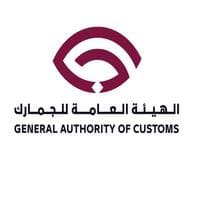
Official Website: https://www.customs.gov.qa/
Poland Customs
Official name: General Customs Directorate of the Republic of Poland
Official website: http://www.mf.gov.pl/
Required documents for customs clearance
Understandably, grappling with customs clearance can be stressful. What documents are needed? We'll demystify this process and define essential papers like the Bill of Lading, Packing List, Certificate of Origin, plus those complex Documents of conformity. You'll gain confidence to tackle customs like a pro.
Bill of Lading
Shipping goods between Qatar and Poland? Then, one document you can't miss is the Bill of Lading. Think of it as your 'proof of purchase' for your shipment, marking the key moment when ownership transfers from the seller to you - kinda similar to getting the keys to a new house. It's crucial for sea freight, but for air cargo, you'll need something similar called an AWB (Air Waybill). These days, instead of the good old paper version, you can opt for an electronic release - or a 'telex' release. It's speedy, efficient and means no more worrying about losing important documents! So, remember, with your Bill of Lading or AWB set, you've got your ticket to that seamless customs clearance.
Packing List
Navigating the shipping landscape between Qatar and Poland can feel like a challenge, but having an accurate Packing List is crucial. Think of the Packing List as your shipment's ID card. Whether you're shipping by sea or air, your package won't get very far without one. Its precise contents, including details of the goods, their quantity, and their weight need to be meticulously recorded — an oversight here can cause significant delays. Let's say, for instance, you're exporting 20 boxes of car parts from Doha to Warsaw; your Packing List should transparently itemize each part. This document is often cross-checked against the Commercial Invoice for customs purposes. So, remember - every piece of information matters, even if it's a single nut or bolt. Accurate paperwork expedites the customs process, ensuring your goods reach their end location swiftly and hassle-free. Happy shipping!
Commercial Invoice
Drafting a flawless Commercial Invoice is your first step to smooth shipping between Qatar and Poland. It should brim with essential details including product description, unit value, total value, and HS codes. For instance, let's say you're shipping electronic gadgets. Your invoice must enlist every item, its unit cost, and total cost explicitly. Don't neglect HS codes, these numerical representations are universally recognized, aiding customs in duty calculation. Remember, coherence is king! Cross-check all details with other shipping documents like the packing list. When everything aligns, customs is a breeze. Enjoy hassle-free freight forwarding by paying attention to these fine details!
Certificate of Origin
The Certificate of Origin (CO) is your ticket to smoother shipments from Qatar to Poland. Think of it as the ID card for your container load, detailing precisely where each item was made. Customs officials rely heavily on this document, so don’t leave any room for ambiguities. Say you're transporting furniture made in Doha—the CO must clearly state 'Made in Qatar'. This small clarification can unlock preferential customs duty rates under bilateral agreements, significantly reducing your costs. Always consult with your local Chamber of Commerce before preparing the CO to ensure you're hitting the right notes. Get this right, and you've successfully navigated one of the most important milestones in your shipping journey.
Certificate of Conformity (CE standard)
When shipping goods between Qatar and Poland, ensuring compliance with European CE standards is a top priority. CE marking is a mandatory conformity mark for diverse product categories within the European Economic Area, including Poland. Unlike quality assurance which is company-specific, the CE mark standardizes product safety across manufacturers, simplifying your entry into the European market. However, be mindful: it's not akin to any US standard. To secure success, conduct a rigorous self-assessment or consider third-party inspection services. You'll expedite customs clearance, avoid costly delays, and navigate smoother waters in the Polish markets. After all, achieving seamless, dependable shipping between Qatar and Poland requires dotting your I's and crossing your T's on compliances.
Your EORI number (Economic Operator Registration Identification)
Shipping between Qatar and Poland? You'll need an EORI number - a must-have for smooth sailing through customs. Acting as your unique identifier, it tracks your imports and exports within the EU (Yes, Poland's included!). Don't have yours yet? Get onto the registration pronto. Remember, every shipment is synonymous with your EORI; it's like your business passport in the EU trading world. So, whether you're a business large or small, or an individual shipping goods, this number is your golden ticket to successful trade. It’s not just an EU requirement, other countries may ask for your EORI too. Get it right, and you've conquered one of the most crucial steps in international shipping!
Get Started with DocShipper
Navigating Qatar and Poland's intricate customs can be quite daunting. Don't fret! DocShipper can spearhead every step, ensuring a seamless clearance process. Why be burdened with paperwork and red tape? Let us handle it all. Grant yourself peace of mind by contacting us today for a free, no-obligation quote. Expect our response in less than 24 hours!
Prohibited and Restricted items when importing into Poland
Understanding what products you can’t ship into Poland can spell the difference between a smooth transaction and a logistical nightmare. Our guide helps you identify items that are off-limits or need special permissions to avoid penalties and supply chain hitches.
Restricted Products
1. Pharmaceutical Goods: These require a special permit from the Office for Registration of Medicinal Products, Medical Devices, and Biocidal Products (URPL).
2. Chemical Substances: You'll need a permit from the Bureau for Chemical Substances.
3. Firearms & Ammunition: Your business must secure a license from the National Police Headquarters (KGP).
4. Telecommunication Equipment: Get your authorization from the Office of Electronic Communications (UKE).
5. Alcohol & Tobacco: You will have to apply for a permit through the Ministry of Finance (MF).
6. Plants, Plant Products & Seeds: You must get phytosanitary certificates from the Main Inspectorate of Plant Health and Seed Inspection (PIORiN).
7. Animal and Animal Products: You'll need to secure a license from the General Veterinary Inspectorate (GIW).
8. Certain Works of Art, Collectors' Pieces and Antiques: These require a special permit from the Ministry of Culture and National Heritage (MKiDN).
Remember, as with any country, the list of restricted items can change and it's crucial to stay up-to-date with the latest information to avoid potential hurdles in your shipping process.
Prohibited products
- Narcotics and drugs: This includes substances like marijuana, cocaine, and other illicit drugs. Legal pharmaceuticals require relevant paperwork.
- All forms of asbestos
- Counterfeit currency and counterfeit goods
- Endangered species products: These include any goods made from the parts of endangered animals or plants.
- Explosives, fireworks and hazardous materials
- Weapons of all types: This includes firearms and ammunition.
- Certain agricultural products: You cannot import plants, seeds, and some food items due to risks to local agriculture. This list changes depending on outbreaks and other factors.
- Pornographic material and substance
- Cultural artefacts and national treasures: This includes items of historical, cultural or paleontological interest, unless they have a certificate of legality.
- Items bearing false origin: Goods with false country of origin markings are prohibited.
- Gold: Unwrought, semi-manufactured or powder form, without approval.
Remember to check the most recent list from the official customs agency of Poland as the list might be updated or expanded. Additionally, even if a type of product is not listed, restrictions may apply to certain brands or goods within those categories.
Are there any trade agreements between Qatar and Poland?
Yes, businesses should note that as of now, there are no specific Free Trade Agreements (FTAs) or Economic Partnership Agreements (EPAs) between Qatar and Poland. However, bilateral relations and trade cooperation have been progressively intensifying, with ongoing dialogues to boost economic partnerships. For instance, the Qatar-Poland Business Council plays a key role in fostering trade. The lack of direct shipping infrastructure could be a challenge, but on the brighter side, continuous discussions indicate potential future improvements.
Qatar - Poland trade and economic relationship
Qatar and Poland share a robust and burgeoning trade relationship that originated from diplomatic relations, established in 1989. Over time, these nations have honed an economic partnership characterized by investment reciprocity and vibrant trade in various sectors, including petroleum, construction, and food.
Poland exported goods worth $148 million to Qatar, while Qatar exported products valued at $20.8 million to Poland. Over the past 27 years, Poland's exports to Qatar, including gas turbines and carbon-based electronics, have grown at an annualized rate of 32.3%, reaching $148 million. Similarly, Qatar's exports to Poland, such as ethylene polymers and raw plastic sheeting, have seen a 21.1% annualized growth rate, totaling $20.8 million in 2022.
Your Next Step with DocShipper
Shipping between Qatar and Poland can seem complex with all the regulations and procedures. As a first-time importer/exporter confusion must be peaking. Don't let these hurdles impede your journey. At DocShipper, we alleviate these pain points and ensure smooth sailing for your cargo. Trust us for a seamless shipping experience. Get in touch now!
Additional logistics services
Discover a world beyond shipping and customs - embrace convenience with DocShipper's comprehensive suite of logistics services. We're your one-stop solution, managing your supply chain from start to finish for a seamless experience. Let us do the hard work!
Warehousing and storage
Seeking a foolproof warehousing solution? It's not a walk in the park given the need for ideal conditions like temperature control for specific goods. Imagine your delicate chocolate shipment melting on arrival! Avoid such sticky situations with DocShipper's reliable warehousing.
Packaging and repackaging
When shipping goods from Qatar to Poland, an experienced agent is key to ensuring items arrive intact. Ever dealt with damaged ceramics or leaking oils? Proper packaging can save you from such headaches. Our team provides tailored packaging solutions that cushion and protect your items, from fragile glassware to robust machinery. Choosing to repackage your goods could mean the difference between profit and unnecessary loss.
Cargo insurance
Taking a leap without cargo insurance can be akin to playing with fire; it's all smooth sailing until an accident takes place. Here's a twist: think of cargo insurance as your safety net. Unlike fire insurance covering only fire incidents, this package is your shield against all perils on the sea, road, air, or rail. Picture this: A container drops overboard during a rough sea voyage or a trucking accident on a slippery highway - cargo insurance steps in to cover your losses and ensures your business remains unscathed.
Supplier Management (Sourcing)
Looking to conquer foreign markets like Asia or East Europe? The prospect might seem daunting. But incredibly, DocShipper plays the crucial role in your journey. It helps you unveil suppliers and manages the whole procurement process. Language gaps? Not an issue, we bridge those as well, leading you fearlessly through the process. A real-world example? Think sourcing toys from China or ceramics from Poland - hassle-free. Ready to take the plunge?
Personal effects shipping
Shipping your cherished personal effects between Qatar and Poland? We have you covered. Our experts ensure fragile family heirlooms or bulky furniture are handled with care, accounting for their unique needs. Imagine safely shipping your grandmother's antique mirror or your favorite oversized recliner hassle-free. That's the peace of mind we offer.
Quality Control
Overseeing the quality of goods before they journey from Qatar to Poland can save time, expenses, and enhance customer satisfaction. For example, our quality control service helped a furniture exporter spot inconsistent upholstery and fix it before shipping, thus avoiding returns and additional shipping costs. A check like this ensures your products meet both countries' standards, reducing shipment delays at customs.
Product compliance services
To avoid unexpected hiccups in your shipment, compliance with product regulations is key. That's why we offer dedicated laboratory testing for your goods, ensuring they meet every standard necessary at your destination. Just imagine the peace of mind knowing your shipment would face no customs hindrance due to non-compliance, it's like a smooth sail across the ocean.
FAQ | For 1st-time importers between Qatar and Poland
What is the necessary paperwork during shipping between Qatar and Poland?
To ship from Qatar to Poland, you'll need a few key forms. The bill of lading is required for sea freight; for air cargo, you'll need an air waybill. Rest assured, we handle these directly at DocShipper. What we need from you are the packing list and commercial invoice. Depending on your goods, other documents such as Material Safety Data Sheets (MSDS) or certifications may be necessary. Don't worry, we're here to assist with all your document needs to ensure a smooth shipping process.
Do I need a customs broker while importing in Poland?
While it's not absolutely required to use a customs broker when importing goods into Poland, we highly recommend it due to the complexity involved in the process. As your representative, a customs broker handles mandatory details, provides necessary documents, and interacts with customs authorities on your behalf. At DocShipper, our role extends beyond just shipping. We represent your cargo at customs for the majority of shipments, ensuring compliance with import regulations and procedures, and providing a smooth, hassle-free import process. With our expertise and thorough handling, you can focus more on your business and less on logistics.
Can air freight be cheaper than sea freight between Qatar and Poland?
Yes, air freight can occasionally be cheaper than sea freight between Qatar and Poland, especially when your shipment is less than 1.5 Cubic Meters or weighs under 300 kg (660 lbs). However, exact costs vary depending on factors like route, weight, and volume. Here at DocShipper, we're all about seeking the most cost-effective and convenient solution for your shipping needs. You can count on our dedicated account executives to provide the most competitive option tailored to your requirements. Always remember, the best shipping method is highly context-specific and should be evaluated on a case-by-case basis.
Do I need to pay insurance while importing my goods to Poland?
Opting for insurance when importing goods to Poland isn't a requirement. Yet, we at DocShipper strongly advise having it. Regardless of whether you're shipping locally or internationally, goods may encounter a variety of incidents such as damage, theft, or loss. Having insurance serves as a safety net against these unpredictable events and can save your business from unplanned financial burdens. So, while you may proceed without insurance, remember it's a layer of protection worth considering for peace of mind and financial protection.
What is the cheapest way to ship to Poland from Qatar?
Given the significant geographical distance between Qatar and Poland, sea freight is the most cost-effective shipping method, especially for bulky or heavy shipments. It takes more time than air freight, but it's much cheaper. Be sure to plan in advance to accommodate the longer transit times. We at DocShipper can guide you through the entire process to ensure your goods get to Poland smoothly and cost-effectively.
EXW, FOB, or CIF?
Choosing between EXW, FOB, or CIF depends on your relationship with your supplier. Not all suppliers are experts in logistics, so it may be more efficient to entrust this task to us at DocShipper. Typically, suppliers sell under EXW (their factory door) or FOB (inclusive of all local charges until the original terminal). Regardless of these terms, we provide a comprehensive door-to-door service, handling international freight and destination processes. This ensures smooth operations and saves you the stress of dealing directly with various objects of the supply chain. Trust us to simplify your shipping process.
Goods have arrived at my port in Poland, how do I get them delivered to the final destination?
Upon arrival of your goods at the destination port in Poland, you need the service of a custom broker or freight forwarder to handle clearance at the terminal and settle import charges. They also coordinate delivery to the final location. We at DocShipper can manage this for you under DAP incoterms, overseeing the entire process. Please confirm these details with your account executive.
Does your quotation include all cost?
Absolutely, our quotes provide a comprehensive overview of all costs, leaving no room for hidden fees or unpleasant surprises. However, it's key to note that duties and taxes at the intended destination are the exception, as those are dependent on local regulations. Still, you can rely on your dedicated account executive to help estimate these costs for a more complete budget.
